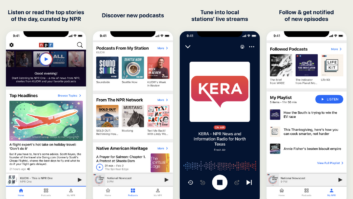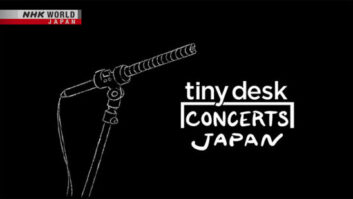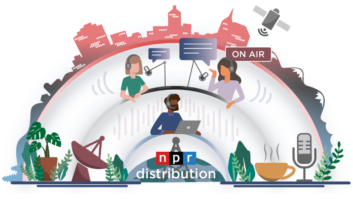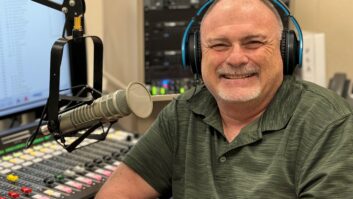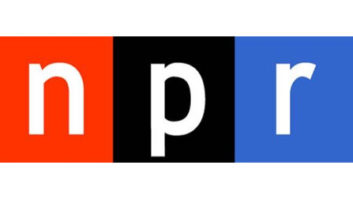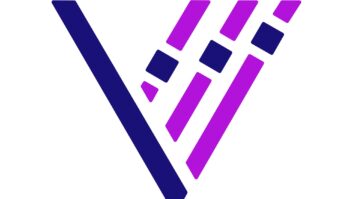
The National Symphony Orchestra in action at NPR’s Studio 1 providing live music for “All Things Considered.”
On Monday National Public Radio decided to walk a tightrope, without a net. It brought in members of Washington’s National Symphony Orchestra to provide a little live background music for the day’s “All Things Considered.”
It was an ambitious project to say the least. A very busy Andy Huether, technical director of NPR’s Studio 1 took some time out from his preparation to give Radio World a peek inside.
Radio World: Describe this ambitious project.
Andy Huether: Several times in the past, our afternoon news program “All Things Considered” has invited musicians to be a “band for a day” for the show. All of the music that is part of the show — breaks, themes, interstitials, etc. — is played live from our Studio 1 performance space and routed to the on-air Studio 31 and mixed into the show. “ATC” has hosted Los Straitjackets in 2012 and Thievery Corporation in 2015, and our early show Morning Edition hosted Yo La Tengo also in 2015. Monika Evstatieva, the producer and director at “ATC” who originally came up with the concept and masterminded the previous “ATC” appearances decided to try to outdo herself by asking the National Symphony Orchestra to come and bring as many players as they thought they could fit into the studio. That turned out to be about 75.
RW: That’s more than just a typical band or soloist. Can you handle a group this big and have you handled such a group before?
Huether: We’re very thrilled for this opportunity and ready for the challenge of capturing the performance. We haven’t had quite as big a group in this studio before, but between myself and co-engineers Neil Tevault and Brian Jarboe, we have a fair amount of experience in both this studio and venues across the country.
RW: What particular problems does a large ensemble bring with it?
Huether: Well, fitting them all into a 45-foot x 60-foot studio is probably the least of our challenges (that’s just barely the size of the NSO’s stage layout!), but mainly I’m concerned with how the room will respond to this many players. The layout will be fairly cramped, so I believe getting microphones placed appropriately will take some work not just in terms of real estate, but more importantly in getting them to capture the ensemble with enough breathing room and avoiding comb filtering issues. The dynamics of the orchestra are also a concern; louder passages may affect balance and overload a space of this size. This will be the first time we’ve had a group of musicians in the studio capable of the high SPL of a full orchestra at fortississimo!

Studio 1 Tech Director Andy Huether and Monika Evstatieva, a producer and director for “All Things Considered” in the Studio 1 control room during the show. The NSO is in the adjoining room behind Evstatieva.
RW: In many ways this is a throw-back to the days when some radio stations actually had an in-house orchestra.
Huether: That’s a very interesting observation. Obviously, economics and flexibility have played large roles in the decline of that practice amongst broadcasters. It’s fascinating to consider that what was once a standard practice has become a novelty special broadcast. It really puts one in awe to imagine the talent and discipline of everyone involved in those productions, especially when confronted with the challenge of doing just this one!
RW: Is all of this work being done by in-house technical staff or do you have to call in extra hands or rent extra equipment?
Huether: NPR has a long history of producing music programming, and we have a vast amount of institutional knowledge and quality gear that we can tap into. So yes, we have lots of resources in-house!
RW: Who are the key people in this project?
Huether: As I mentioned, Monika Evstatieva, a producer and director with “All Things Considered,” is the mastermind behind the whole idea, and she’s been coordinating logistics with the NSO Production Managers Daryl Donley and Krysta Cihi and planning program and song selection with Director of Artistic Planning Nigel Boon. Carline Watson is the executive producer of “ATC” and is responsible for greenlighting and overseeing the project and how it fits into the structure of her show. Ari Shapiro and Audie Cornish are very excited to be hosting the show that day, and Audie will be running down two flights of stairs to our performance studio for the last segment of the show when she’ll chat with conductor Steven Reineke and trombonist David Murray. I’ve had a lot of support from my fellow technicians Neil Tevault and Brian Jarboe and Electronics Engineers Joe Mills and Gene Gerhiser as well as the wider engineering team including Managing Director of Technology Strategy and Audio Engineering Chris Nelson and Technology Strategist Kevin Wait. The Facebook video production is being spearheaded by Claire O’Neill and Becky Lettenberger, and Colin Marshall is the technical director switching that video. There are many people working hard to make this happen and I wish I could credit them all!

A microphone tree in Studio 1. NPR’s Managing Director of Technology Strategy and Audio Engineering Chris Nelson lays out the complement: On the far ends of the microphone tree are Neumann KM63s spaced omni. This was the pair that was chosen for the main pick up of the orchestra for the broadcast. In the center of the tree the two black microphones stacked on top of one another are a Sennheiser MKH 40 and Sennheiser MKH 30 in a mid-side configuration. There are also two pairs of microphones in an ORTF configuration in this arrangement. The top pair is Neumann KM 140s, the bottom pair is Sennheiser MKH 40s. Ultimately the main mix was comprised of Neumann KM 63s in a spaced pair configuration; mixed with some Sennheiser MKH 20 flanks about 10 feet to the left and right of the conductor. We also used a handful of spot mics which are identified on the Input List (see picture below).
RW: What are the key concerns or failure points to be watched?
Huether: Communication is always key when dealing with multiple locations coordinating a single broadcast. The Lawo MADI network we have throughout the building provides a huge amount of flexibility and interconnectivity. There are PTT panels that provide communication between any positions in any studios in the building. We’ve also set up a Polycom video conference system between Monika who will be in Studio 1 control room and Jinae West who will be directing the show from Studio 31 control room. Our shows all run on very regimented clocks that divide the hours into segments, breaks, funding credits, etc., and we’ll be able to route the timecode signals of the clocks that count down these segments from Studio 31 down to Studio 1. We want to be sure we have music ready when Jinae needs it in the studio!
RW: Do any of the instruments present their own problems?
Huether: The instrument I’m most concerned about is the room itself! More than any individual instruments, the balance of the whole seems like it will be most challenging. The assumed acoustic signature of an orchestra is going to be set in a concert hall, so recreating that feel in a smaller space, maintaining a good balance and natural sound will be our goal. Without the space and volume of a hall in which the instruments can blend on their own, we’ll need spot mics on almost all the sections. The nature of the performance as interstitial music in a news show also presents problems in being able to be prepared for what will be played. Generally, directors of our shows will choose music that suits the tone of the news pieces they abut, choosing recordings from a large library of music immediately before and even during the show. Using live performers with a limited rehearsed repertoire, those choices become more difficult. The show is trying its best to solidify the run of the show to make this easier, but it is a news show, so it’s impossible to nail it down 100%.
RW: Describe the signal route (and equipment) that gets the sound from the player’s instrument all the way into the distribution system and the mix.
Huether: We’re using a wide array of microphones to be sure we have choices to achieve the best sound: Neumann RSM 190, KM 140, KM 63, KM 130, U 87, TLM 170, KM 84, Sennheiser MKH 40, MKH 20, Coles 4038 … all through our cleanest outboard preamps, Millennia HV3D. The Studio 1 console is a Lawo mc266, and I’ll be adding space with a TC Electronic 6000 processor. Master Control will route the Studio 1 program up to Studio 31 through our Lawo switcher, and Zach Coleman will be mixing “All Things Considered” in Studio 31 on a Lawo Sapphire console. Talent microphones throughout the facility are all U 87 for consistency, and we’ll be using them in Studio 1 as well for the chat at the end of the show.

The microphone input list resting below one of the Millennia Media HV3D eight-channel preamps.





